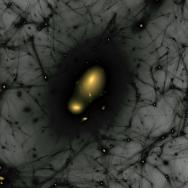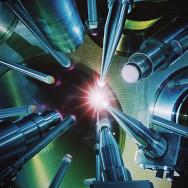When supermassive black holes have tantrums, galaxies sit up and take notice.
A group of scientists announced they had detected the gamma rays from a phenomenon known as an ultra-fast outflow—a powerful wind launched from very near a supermassive black hole—for the first time. Scientists believe these outflows play an important role in regulating the growth of the black hole itself and its host galaxy.
Using data gathered by the Large Area Telescope onboard NASA’s Fermi Gamma-ray Space Telescope and a stacking technique combining signals too weak to be observed on their own, researchers detected gamma rays from ultra-fast outflows in several nearby galaxies. The team, including scientists with the University of Chicago, Clemson University, the College of Charleston and many others, published the results Nov. 10 in The Astrophysical Journal.
They results, they said, should help us understand what happened as our own Milky Way galaxy formed and grew.
“Our gamma-ray observations show how supermassive black holes can transfer a large amount of energy to their host galaxy,” said Chris Karwin, a postdoctoral fellow at Clemson University and leader of the study. “Although these winds are challenging to detect, it is thought that they play a significant role in how a massive black hole and the host galaxy itself grow.”
‘Tsunami-like winds’
Every galaxy has a supermassive black hole at its center. Some are dormant. Others, called active galactic nuclei, are active, meaning that they draw in and “eat” the surrounding matter.
But contrary to popular assumption, black holes don’t eat literally everything near them. “Black holes are like powerful vacuum cleaners that eject some of the dirt that gets near them instead of sucking in everything,” said Marco Ajello, an associate professor at Clemson University who is co-leading the study. “These ejections, which are tsunami-like winds, are made of highly ionized gas.”
When this gas interacts with the matter that exists between star systems, it creates powerful shock waves. In this way, black holes transfer an enormous amount of energy to their host galaxies, explained Karwin.
“These ultra-fast outflows act like a piston and actually accelerate charged particles, known as cosmic rays, to near the speed of light,” he said.
These cosmic rays go on to collide with particles in the host galaxy, eventually producing the gamma rays that the scientists detected.
“That gamma-ray emission encodes a ton of information,” said Rebecca Diesing, a graduate student at the University of Chicago and co-author on the paper. “That includes how it evolved, how it accelerates cosmic rays, and how it interacts with material in the host galaxy.”
Working with Asst. Prof. Damiano Caprioli of UChicago’s Department of Astronomy and Astrophysics, Diesing developed state-of-the-art computational modeling techniques to calculate how particles can be accelerated in astrophysical environments, especially at the powerful shock waves produced by the winds, and how such very energetic particles emit gamma-rays. Together, this information helps understand how these ultra-fast outflows evolve.
These outflows affect the galaxies around them in multiple ways. For example, scientists think that these ultra-fast outflows inject energy into the galaxy, which breaks apart clouds of gas that might otherwise form into stars and feed the supermassive black hole. “This becomes a self-regulating processes, which physically links supermassive black holes with their host galaxies, causing them to grow together,” said Diesing.
“The black hole at the center of the galaxy and the galaxy itself have a mechanism to grow together in mass—and this is the mechanism,” Ajello said.
Understanding the Milky Way
The findings of the study could help scientists understand what happened in our own Milky Way galaxy.
Sagittarius A* is the supermassive black hole at the center of the Milky Way with about four million times the sun’s mass. Extending above and below the Milky Way’s disc are “Fermi bubbles,” enormous round structures of hot gas emanating from the galactic center. (They’re called Fermi bubbles because the Fermi Gamma-Ray Space Telescope, the source of the data in the current study, discovered them in 2010.)
“Today, our black hole, Sagittarius A*, is not active, but it’s possible it was active in the recent past, maybe up until a few hundred years ago,” Karwin said. “Our model supports the hypothesis that these Fermi bubbles may be remnants of past ultra-fast outflow-like activity from the supermassive black hole in the center of our galaxy.”
Ajello said future work includes studying galaxies that have had active ultra-fast outflow winds for tens of millions of years that have already traveled to the outskirts of the galaxy.
Citation: “Gamma Rays from Fast Black-hole Winds.” Ajello et al, The Astrophysical Journal, Nov. 10, 2021.
Funding: National Science Foundation, NASA, Eugene & Niesje Parker Fellowship Fund.
—Adapted from an article published by Clemson University.

